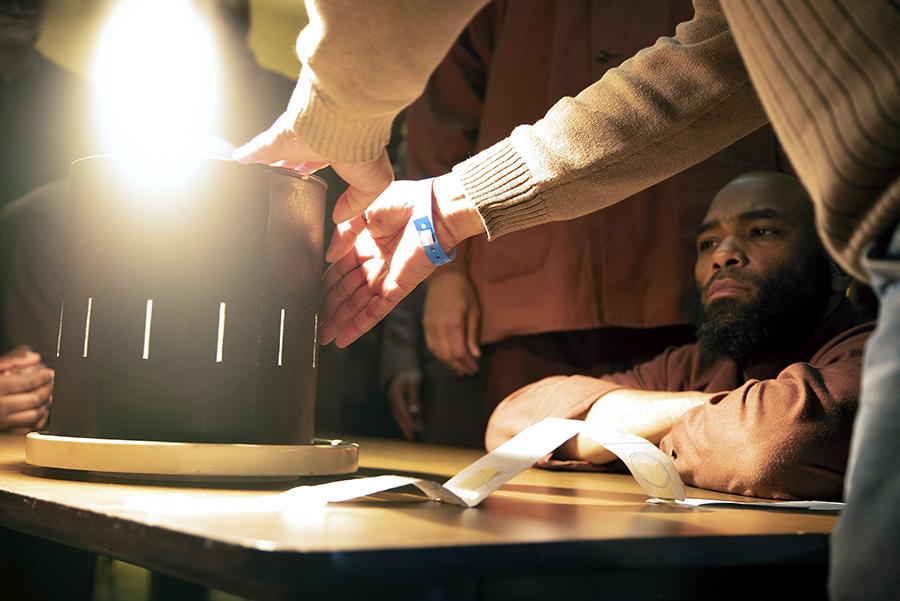Through Sept. 12, the facade of the historic Eastern State Penitentiary will flicker with footage from 20 animated short films made by incarcerated people projected onto its Fairmount Avenue exterior.
The videos in Hidden Lives Illuminated, a month-long project that started nightly screenings Aug. 15, are made by incarcerated artists at the Pennsylvania State Correctional Institution at Chester and Philadelphia’s Riverside Correctional Facility for Women. The films play during roughly 40-minute showings, which take place at the top of the hour from 7-9 p.m., and follow weekly themes: “The View from Inside,” “Criminal Justice Today,” “Family and Community Impact,” and “Restorative Justice.”
The project, which has been in the works for about three years, gives viewers a glimpse inside the criminal justice system, with stories written, narrated and animated by those in prison.
The films are important because they shed light on the experiences of incarcerated people and those of other marginalized communities who are often stigmatized, said Christina “Starfire” May, Hidden Lives Illuminated storytelling coach and script advisor.
May, who has a background in theater, helped the filmmakers write and edit their scripts and aided with creating voiceovers. May began working with the incarcerated artists by drafting poems with them, to start getting ideas flowing for the films’ plots. 5
“I hope they’re able to connect to that humanity of these people because you might have biases about people in prison,” said May, a queer Black woman. “[When] you get to meet them and hear their stories, you really start to see them as human beings.”
One participant, Lamar L., used his piece to encourage his children to learn from his mistakes and strive to be leaders. A short by Brian H. shows the filmmaker writing a letter to “Time,” reflecting on loss, gratitude and pondering if time truly heals all wounds. Other films by individuals at the Riverside Correctional Facility for Women explore daily life inside the county jail.
Sean Kelley, director of interpretation at Eastern State Penitentiary and project lead, said the program is meant to deepen conversations around criminal justice reform.
“Prisons are some of the most inaccessible spaces in America,” Kelley said in a release. “After all, prison walls don’t just keep incarcerated people in, they keep the public out. We want to use our wall to illuminate the lives of people living inside these institutions that are so often misunderstood, or worse, ignored.”
Presentations by scholars, community leaders, activists, artists, victims’ advocates and elected officials will take place in tandem with the screenings. The penitentiary is also organizing hands-on activities like art-making, letter writing and lightning talks from leaders in criminal justice reform, restorative justice and reentry to further encourage viewer engagement with the films.
Out lesbian Annie Anderson, project support and Eastern State Penitentiary’s manager of research and public programming, said she hopes the films make viewers question the U.S. justice system, how prisons work and their efficacy.
“This particular project speaks to me in that it’s unearthing these stories, excavating these narratives that we don’t really get to see or encounter because of all of the systems in play that are part of our criminal justice system,” she said, “like racism, classism and people not really having opportunities to be able to tell their stories and be valued human beings.”
On the final night of Hidden Lives Illuminated, all 20 films will be screened back to back. A documentary about the participants will show inside the penitentiary’s cell blocks.
Anderson said she hopes participating in the project can help the filmmakers reintegrate with society upon their release.
“The odds are so stacked against people who are reentering from prison,” she added. “It’s really hard to find employment, to find housing, to get student loans, to get an education. There are so many barriers that people face that are real physical barriers to reentry, and then not to mention all of the confidence barriers.”
For May, the goal is for viewers to “hear the stories with their hearts” and challenge misconceptions about incarcerated people.
“If we can get a piece of their heart, get a piece of who they are and you get a story, then maybe their humanity that you see will connect with who you are,” May said “Once you give yourself over to illuminate lives that are hidden, maybe you can have ways … to illuminate those hidden parts in you as well.”
